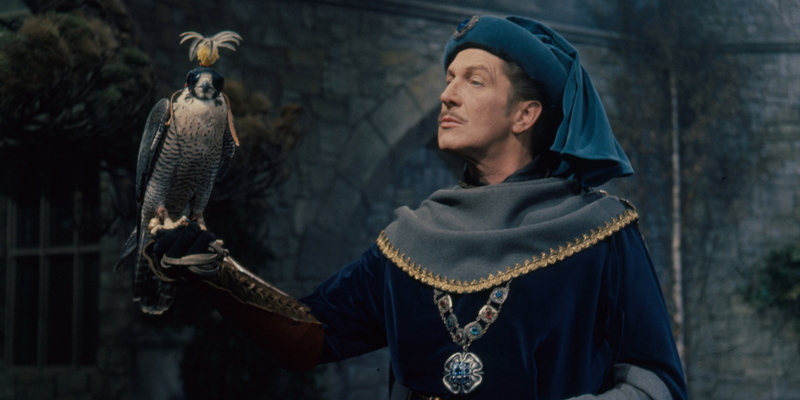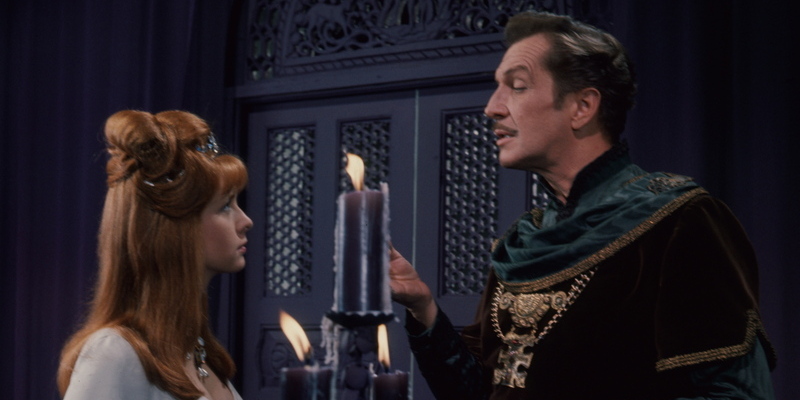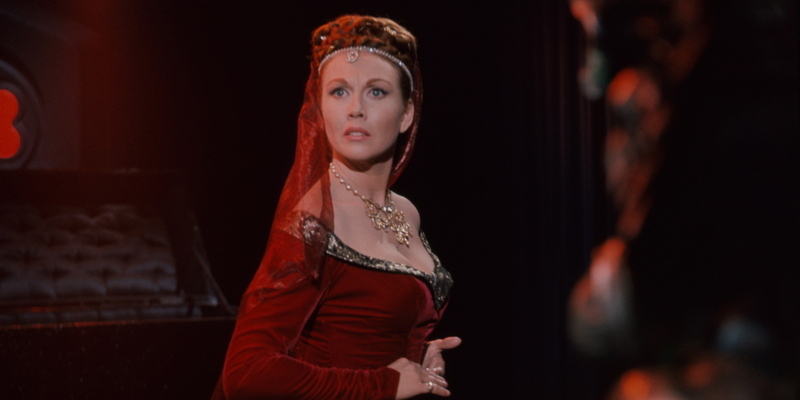
As a plague ravages the land outside his castle walls, a Satanic Prince
sets his sights on corrupting a young Christian woman.
Review by
Eric Hillis
Directed by: Roger Corman
Starring: Vincent Price, Hazel Court, Jane Asher, David Weston, Nigel Green

After establishing himself in the 1950s as a master of knocking out black
and white b-movies on limited budgets and compressed shooting schedules,
Roger Corman entered the 1960s with more artistic aspirations.
Something of a culture vulture, Corman wished to bring the tales of
Edgar Allan Poe to cinemagoers, and in the first five years of the
decade directed no less than seven Poe adaptations (eight if you include
The Haunted Palace, which merely borrows the title of Poe's work).
While still restricted in terms of budget and filming time-frames, Corman's
Poe films boasted an opulence that much like the Gothic horrors of Britain's
Hammer and Italy's Mario Bava, rivalled any big budget Hollywood productions
of the era. Corman was aided heavily by the collaboration of
Vincent Price, and it's this series of films that truly cemented the
actor as a horror icon.

Price is at his most menacing in 1964's
The Masque of the Red Death. Here he plays Prospero, a Satan worshipping prince in medieval Italy who
rules the land with an iron fist, inflicting cruel and usual punishments on
the local villagers. And what a cad he is! When we meet him first he's
forcing a young peasant girl, Francesca (Jane Asher), to choose
whether her lover, Gino (David Weston), or her father, Ludovico (Nigel Green), should be executed after the pair dare to mouth off in the presence of
the prince. Won over by Francesca's innocent charms, Prospero spares Gino
and Ludovico, taking them captive in his castle instead, and invites the
young girl into his luxurious home, where he hopes to convert her to the
ways of Satan.
With a mysterious plague - the "Red Death" - ravaging the land, Prospero
invites the region's nobility to take refuge in his castle, where
entertainment is provided by the dwarf Hop-Toad (Skip Martin, whose
character is borrowed from another Poe story, 'Hop-Frog') and his young
ballerina companion Esmerelda (who in a decidedly creepy touch is played by
child actress Verina Greenlaw but voiced by an adult woman).
What follows is a series of Shakespearean double-crosses and backstabbings
as various characters attempt to outdo one another, much to the delight of
Prospero, as it confirms his misanthropic philosophy. Prospero's mistress,
Juliana (Hazel Court), is jealous of Francesca, and attempts to set
her up in breaking her lover and father out of their jail so Prospero will
have her executed for treason. Meanwhile, Hop-Toad has a vendetta against
Prospero's cruel nobleman friend Alfredo (Patrick Magee) for striking
Esmerelda, and sets about doing him up like a kipper. Prospero laughs all of
this off, delighting in seeing Francesca's reactions to witnessing humanity
at its cruellest.

Corman is arguably better known for the filmmakers he mentored than for his
own work as a director, and here it's a certain Nicolas Roeg who
gets a chance to shine in the role of cinematographer. Along with production
designer Daniel Haller and art director Robert Jones, Corman
and Roeg create a visually sumptuous film that infuses classic Gothic
sensibilities with 1960s pop-art aesthetics. Far from the shadowy, cobweb
riddled castles audiences were accustomed to at that point, Prospero's
palace is bright and polished, its colour coded rooms no doubt an influence
of the design of the ballet academy of Dario Argento's Suspiria.
That Prospero conducts his atrocities in such well lit surrounds makes them
all the more horrifying. In a fiendish sequence that may have inspired the
famous Russian roulette set-piece of Michael Cimino's
The Deer Hunter, Prospero has Gino and Ludovico take turns cutting themselves with a
selection of five knives, one of which has been dipped in poison. Who thinks
up such horrors? Not Poe; this subplot was a creation of screenwriters
Charles Beaumont and R. Wright Campbell.
Corman's quest to bring highbrow culture to the drive-in circuit sees him
pull from the world of ballet for two sequences - one a drug-induced
hallucination that owes much to Stravinsky and prefigures his later ode to
LSD, The Trip; the other a macabre dance of death that sees Red Death afflicted corpses
come to life and surround Prospero (not unlike the climax of William
Lustig's Maniac).

There's much to delight in here, but ultimately it's Price who is the
film's MVP. Yes, by today's standards his performance might be considered
hammy, but there's a time and place for ham, and the court of a wicked
medieval prince proves the perfect stage for Price's unique delivery. As
enamoured of Poe as his director, Price plays the evil Prospero with relish,
a constant glint in his eye. You might say this is the American equivalent
of Olivier translating Shakespeare. In Price, Corman found the perfect
frontman to bring life to Poe's words.
Watching The Masque of the Red Death in the middle of a
pandemic proves eerily prescient, as the wealthy hole up within their
comfortable walls while the plebs worry about their survival in a plague
ravaged world. A lot of filmmakers are currently shooting movies within
their homes - perhaps one could opt for a modern adaptation of Poe's tale,
transforming Prospero into an Instagram "celeb" walled up in a Dubai hotel
room with their assorted hangers-on and sycophants?

You get to choose between the theatrical cut and the newly restored
extended cut; new interview with film scholar Keith M. Johnston; new
feature commentary with critic Kim Newman and filmmaker Sean Hogan; a
filmed 2013 conversation between Newman and Roger Corman; four art cards;
booklet with an essay by preservationist Tessa Idlewine.

The Masque of the Red Death (4K
restoration) is on UK Digital, DVD and blu-ray from January 25th.
